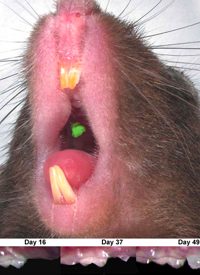
Scientists from Tokyo University have successfully grown bioengineered replacement teeth in the mouths of mice, according to their August 3 report at the website of Proceedings of the National Academy of Sciences of the United States of America.
The Japanese scientists were researching regenerative therapy, which they describe as seeking to “develop fully functioning bioengineered organs which work in cooperation with surrounding tissues to replace organs that were lost or damaged as a result of disease, injury, or aging.” Their success with mice may be a first step toward applying the technology to human beings.
“We report a successful fully functioning tooth replacement in an adult mouse achieved through the transplantation of bioengineered tooth germ into the alveolar bone in the lost tooth region,” the scientists write. The tooth germ was taken from the molar tooth germ of a mouse embryo, which apparently represents not embryonic stem cells but cells that had already developed to contain everything needed to form teeth. The tooth germ was then grown in an organ culture, and a green fluorescent protein was incorporated that would glow under ultraviolet light to make the new teeth easier to identify.
Molar teeth were removed from a number of mice and then replaced with the bioengineered tooth germ. Eventually new teeth sprouted that were as hard as the originals, showed signs of proper nerve development, and glowed green under ultraviolet light. “The bioengineered tooth, which was erupted and occluded, had the correct tooth structure, hardness of mineralized tissues for mastication, and response to noxious stimulations such as mechanical stress and pain in cooperation with other oral and maxillofacial tissues,” the scientists reported.
The researchers conclude that their study “provides evidence of a successful replacement of an entire and fully functioning organ in an adult body through the transplantation of bioengineered organ germ, reconstituted by single cell manipulation in vitro.” They note that this could make “a substantial contribution to the development of bioengineering technology for future organ replacement therapy.”
Interestingly, the Japanese scientists specifically mention adult stem-cell research as the next step in completely replacing teeth: “Further studies on the identification of available adult tissue stem cells for the reconstitution of a bioengineered tooth germ … will help to achieve the realization of tooth regenerative therapy for missing teeth.”
Whether or not the mouse embryo suffered irreparable damage from donating its molar tooth germ did not seem to be addressed by the Japanese scientists, but perhaps they realize that using human embryos as donors would have serious ethical and moral implications. Adult stem cells, already showing so much promise in practical medical treatments, would be the next logical step for replacing missing teeth and other parts of the body. Using a person’s own adult stem cells would certainly reduce the risk of organ rejection that would accompany any embryonic stem-cell therapy.
The incorporation of green fluorescent protein into the teeth brings up one final point about what will someday be the next fad after body piercing and tattoos: bioengineered body modification. Someone somewhere someday will inevitably think it is cool or rad or hip or sick or whatever future slang term will eventually come into vogue to have teeth that turn green in ultraviolet light, hair that glows in the dark, or fingernails that are perfectly black without the need for nail polish.
To the degree that science is eventually able to replace a body part, it will also usher in a whole new era of what some will call body “art.”


